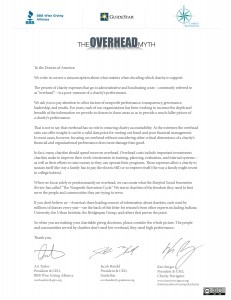“In a historic move, the leaders of the country’s three leading sources of information on non-profits – GuideStar, Charity Navigator, and BBB Wise Giving Alliance – penned an open letter to the Donors of America denouncing the ‘overhead ratio’ as a valid indicator of non-profit performance.” (From overheadmyth.com)

The letter (Click here to enlarge), signed by all three organization’s CEOs reads: “The percent of charity expenses that goes to administrative costs—commonly referred to as “overhead”—is a poor measure of a charity’s performance.”
The sector has too often “erroneously focused on overhead over the past few decades, which has starved non-profits from investing in themselves as enterprises.”
According to overheadmyth.com, this letter marks “the beginning of a campaign to correct the common misconception that the percentage of a charity’s expenses that goes to administrative and fundraising costs is, on its own, an appropriate metric to evaluate when assessing a charity’s worthiness and efficiency.”
Very exciting news indeed! The push back against the “overhead myth” has been growing, and it’s good to see it’s finally having an impact. You’ll remember Dan Pallotta’s bold TED Talk: “The way we think about charity is dead wrong” where he argued, quite convincingly, that the public’s obsession with overhead has been depriving non-profits of the resources they need to create real change.
“There is no greater injustice,” he says “than the double standard that exists between the for-profit and non-profit sectors. One gets to feast on marketing, risk-taking, capital and financial incentive, the other is sentenced to begging.”
And while Pallotta may have been the loudest, he definitely wasn’t the only one making this argument. Here’s a video created by donors’ forum as part of a project called “Real Talk About Real Costs” that makes a similar case.
And The Stanford Social Innovation Review makes this case as well when talking about The Nonprofit Starvation Cycle: A vicious cycle created by funding bodies’ obsession with overhead that has left non-profits “so hungry for decent infrastructure that they can barely function as organizations.”
For far too long non-profits have had to live up to unrealistic expectations about spending, which has limited what they can do.
Let’s hope this letter really is the beginning of change, and that the public begins to appreciate that non-profits must invest in good overhead in order to grow their programs, and serve their mission on a larger scale.
Because in a world where non-profits are judged, not by what they spend, but what they get done, the possibilities for what they can get done are endless. That’s exciting!
P.S. Read our post on Dan Pallotta’s TED Talk.


